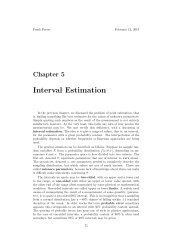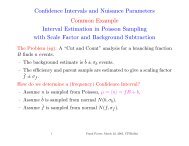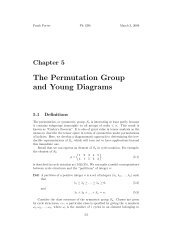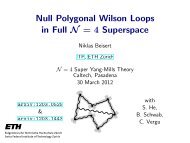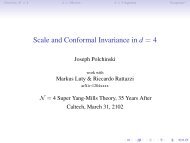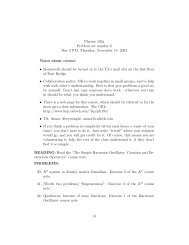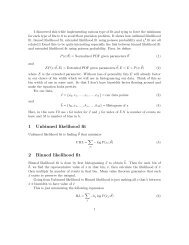1 Introduction 2 Resolvents and Green's Functions
1 Introduction 2 Resolvents and Green's Functions
1 Introduction 2 Resolvents and Green's Functions
You also want an ePaper? Increase the reach of your titles
YUMPU automatically turns print PDFs into web optimized ePapers that Google loves.
4. If H is self-adjoint, then G(x, y; z) is, in fact, our earlier discussed<br />
Green’s function. It is given by Eqn. 59 for all z (including real z),<br />
not in the spectrum of H. The discrete eigenvalues of H correspond to<br />
poles of G as a function of z. Thus, the bound states can be found by<br />
searching for the poles of G, in a suitably cut complex plane (if H has<br />
a continuous spectrum, we have a branch cut).<br />
5.2 Example: Force-free Motion<br />
Let us evaluate the Green’s function for force-free motion, V (x) = 0, in<br />
x ∈ (−∞, ∞) configuration space:<br />
d 2<br />
Hu(x; z) = − 1 u(x; z) = zu(x; z). (64)<br />
2m dx2 We must have u L → 0 as x → −∞, <strong>and</strong> u R → 0 as x → ∞. Then we have<br />
solutions of the form:<br />
where<br />
u L (x; z) = e −iρx , u R (x; z) = e iρx , (65)<br />
ρ = √ 2mz. (66)<br />
We select the branch of the square root so that the imaginary part of ρ is<br />
positive, as long as z is not along the non-negative real axis. We know that<br />
the spectrum of H is the non-negative real axis. Thus, we cut the z-plane<br />
along the positive real axis.<br />
To obtain the Wronskian, note that u ′ L = −iρu L <strong>and</strong> u ′ R = iρu R . Evaluate<br />
at x = 0 for convenience: u L (0) = u R (0) = 1. Hence,<br />
W (z) = (−iρ) − (iρ) = −2iρ = −2i √ 2mz. (67)<br />
Thus, we obtain the Green’s function:<br />
G(x, y; z) =<br />
2m<br />
−2i √ 2mz<br />
[<br />
e −iρx e iρy θ(y − x) + e −iρy e iρx θ(x − y) ]<br />
= i√ m<br />
2z eiρ|x−y| . (68)<br />
We could have noticed from the start that G had to be a function of (x − y)<br />
only, by the translational invariance of the problem.<br />
Let us continue, <strong>and</strong> obtain the time development transformation U(x, y; t):<br />
U(x, y; t) = − 1 ∫<br />
dze −itz G(x, y; z), (69)<br />
2πi C ∞<br />
11




